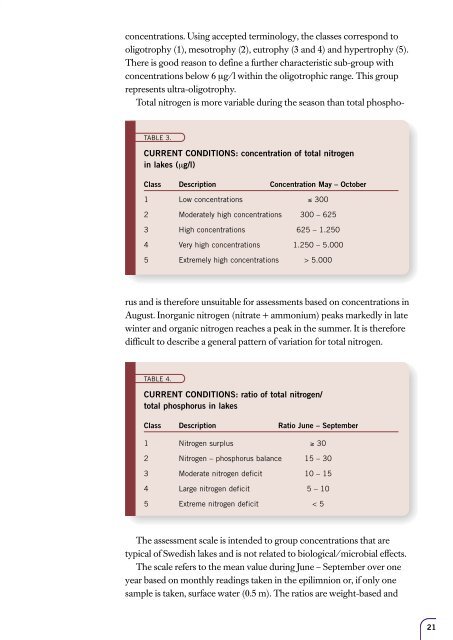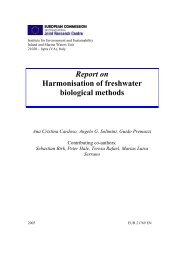Lakes and Watercourses
Lakes and Watercourses
Lakes and Watercourses
You also want an ePaper? Increase the reach of your titles
YUMPU automatically turns print PDFs into web optimized ePapers that Google loves.
concentrations. Using accepted terminology, the classes correspond to<br />
oligotrophy (1), mesotrophy (2), eutrophy (3 <strong>and</strong> 4) <strong>and</strong> hypertrophy (5).<br />
There is good reason to define a further characteristic sub-group with<br />
concentrations below 6 µg/l within the oligotrophic range. This group<br />
represents ultra-oligotrophy.<br />
Total nitrogen is more variable during the season than total phospho-<br />
TABLE 3.<br />
CURRENT CONDITIONS: concentration of total nitrogen<br />
in lakes (µg/l)<br />
Class Description Concentration May – October<br />
1 Low concentrations ≤ 300<br />
2 Moderately high concentrations 300 – 625<br />
3 High concentrations 625 – 1.250<br />
4 Very high concentrations 1.250 – 5.000<br />
5 Extremely high concentrations > 5.000<br />
rus <strong>and</strong> is therefore unsuitable for assessments based on concentrations in<br />
August. Inorganic nitrogen (nitrate + ammonium) peaks markedly in late<br />
winter <strong>and</strong> organic nitrogen reaches a peak in the summer. It is therefore<br />
difficult to describe a general pattern of variation for total nitrogen.<br />
TABLE 4.<br />
CURRENT CONDITIONS: ratio of total nitrogen/<br />
total phosphorus in lakes<br />
Class Description Ratio June – September<br />
1 Nitrogen surplus ≥ 30<br />
2 Nitrogen – phosphorus balance 15 – 30<br />
3 Moderate nitrogen deficit 10 – 15<br />
4 Large nitrogen deficit 5 – 10<br />
5 Extreme nitrogen deficit < 5<br />
The assessment scale is intended to group concentrations that are<br />
typical of Swedish lakes <strong>and</strong> is not related to biological/microbial effects.<br />
The scale refers to the mean value during June – September over one<br />
year based on monthly readings taken in the epilimnion or, if only one<br />
sample is taken, surface water (0.5 m). The ratios are weight-based <strong>and</strong><br />
21















![Accommodation booking form [PDF]](https://img.yumpu.com/39471785/1/184x260/accommodation-booking-form-pdf.jpg?quality=85)

